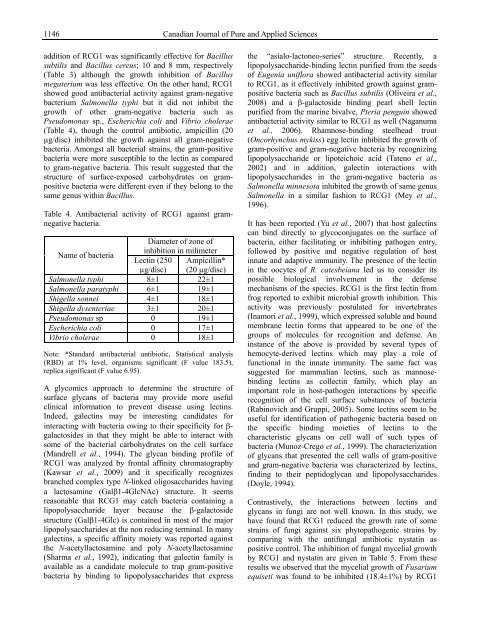Download (5Mb) - Covenant University Repository
Download (5Mb) - Covenant University Repository
Download (5Mb) - Covenant University Repository
Create successful ePaper yourself
Turn your PDF publications into a flip-book with our unique Google optimized e-Paper software.
1146<br />
addition of RCG1 was significantly effective for Bacillus<br />
subtilis and Bacillus cereus; 10 and 8 mm, respectively<br />
(Table 3) although the growth inhibition of Bacillus<br />
megaterium was less effective. On the other hand, RCG1<br />
showed good antibacterial activity against gram-negative<br />
bacterium Salmonella typhi but it did not inhibit the<br />
growth of other gram-negative bacteria such as<br />
Pseudomonas sp., Escherichia coli and Vibrio cholerae<br />
(Table 4), though the control antibiotic, ampicillin (20<br />
µg/disc) inhibited the growth against all gram-negative<br />
bacteria. Amongst all bacterial strains, the gram-positive<br />
bacteria were more susceptible to the lectin as compared<br />
to gram-negative bacteria. This result suggested that the<br />
structure of surface-exposed carbohydrates on grampositive<br />
bacteria were different even if they belong to the<br />
same genus within Bacillus.<br />
Table 4. Antibacterial activity of RCG1 against gramnegative<br />
bacteria.<br />
Name of bacteria<br />
Diameter of zone of<br />
inhibition in milimeter<br />
Lectin (250 Ampicillin*<br />
µg/disc) (20 µg/disc)<br />
Salmonella typhi 8±1 22±1<br />
Salmonella paratyphi 6±1 19±1<br />
Shigella sonnei 4±1 18±1<br />
Shigella dysenteriae 3±1 20±1<br />
Pseudomonas sp 0 19±1<br />
Escherichia coli 0 17±1<br />
Vibrio cholerae 0 18±1<br />
Note: *Standard antibacterial antibiotic, Statistical analysis<br />
(RBD) at 1% level, organisms significant (F value 183.5),<br />
replica significant (F value 6.95).<br />
A glycomics approach to determine the structure of<br />
surface glycans of bacteria may provide more useful<br />
clinical information to prevent disease using lectins.<br />
Indeed, galectins may be interesting candidates for<br />
interacting with bacteria owing to their specificity for βgalactosides<br />
in that they might be able to interact with<br />
some of the bacterial carbohydrates on the cell surface<br />
(Mandrell et al., 1994). The glycan binding profile of<br />
RCG1 was analyzed by frontal affinity chromatography<br />
(Kawsar et al., 2009) and it specifically recognizes<br />
branched complex type N-linked oligosaccharides having<br />
a lactosamine (Galβ1-4GlcNAc) structure. It seems<br />
reasonable that RCG1 may catch bacteria containing a<br />
lipopolysaccharide layer because the β-galactoside<br />
structure (Galβ1-4Glc) is contained in most of the major<br />
lipopolysaccharides at the non reducing terminal. In many<br />
galectins, a specific affinity moiety was reported against<br />
the N-acetyllactosamine and poly N-acetyllactosamine<br />
(Sharma et al., 1992), indicating that galectin family is<br />
available as a candidate molecule to trap gram-positive<br />
bacteria by binding to lipopolysaccharides that express<br />
Canadian Journal of Pure and Applied Sciences<br />
the “asialo-lactoneo-series” structure. Recently, a<br />
lipopolysaccharide-binding lectin purified from the seeds<br />
of Eugenia uniflora showed antibacterial activity similar<br />
to RCG1, as it effectively inhibited growth against grampositive<br />
bacteria such as Bacillus subtilis (Oliveira et al.,<br />
2008) and a β-galactoside binding pearl shell lectin<br />
purified from the marine bivalve, Pteria penguin showed<br />
antibacterial activity similar to RCG1 as well (Naganuma<br />
et al., 2006). Rhamnose-binding steelhead trout<br />
(Oncorhynchus mykiss) egg lectin inhibited the growth of<br />
gram-positive and gram-negative bacteria by recognizing<br />
lipopolysaccharide or lipoteichoic acid (Tateno et al.,<br />
2002) and in addition, galectin interactions with<br />
lipopolysaccharides in the gram-negative bacteria as<br />
Salmonella minnesota inhibited the growth of same genus<br />
Salmonella in a similar fashion to RCG1 (Mey et al.,<br />
1996).<br />
It has been reported (Yu et al., 2007) that host galectins<br />
can bind directly to glycoconjugates on the surface of<br />
bacteria, either facilitating or inhibiting pathogen entry,<br />
followed by positive and negative regulation of host<br />
innate and adaptive immunity. The presence of the lectin<br />
in the oocytes of R. catesbeiana led us to consider its<br />
possible biological involvement in the defense<br />
mechanisms of the species. RCG1 is the first lectin from<br />
frog reported to exhibit microbial growth inhibition. This<br />
activity was previously postulated for invertebrates<br />
(Inamori et al., 1999), which expressed soluble and bound<br />
membrane lectin forms that appeared to be one of the<br />
groups of molecules for recognition and defense. An<br />
instance of the above is provided by several types of<br />
hemocyte-derived lectins which may play a role of<br />
functional in the innate immunity. The same fact was<br />
suggested for mammalian lectins, such as mannosebinding<br />
lectins as collectin family, which play an<br />
important role in host-pathogen interactions by specific<br />
recognition of the cell surface substances of bacteria<br />
(Rabinovich and Gruppi, 2005). Some lectins seem to be<br />
useful for identification of pathogenic bacteria based on<br />
the specific binding moieties of lectins to the<br />
characteristic glycans on cell wall of such types of<br />
bacteria (Munoz-Crego et al., 1999). The characterization<br />
of glycans that presented the cell walls of gram-positive<br />
and gram-negative bacteria was characterized by lectins,<br />
finding to their peptidoglycan and lipopolysaccharides<br />
(Doyle, 1994).<br />
Contrastively, the interactions between lectins and<br />
glycans in fungi are not well known. In this study, we<br />
have found that RCG1 reduced the growth rate of some<br />
strains of fungi against six phytopathogenic strains by<br />
comparing with the antifungal antibiotic nystatin as<br />
positive control. The inhibition of fungal mycelial growth<br />
by RCG1 and nystatin are given in Table 5. From these<br />
results we observed that the mycelial growth of Fusarium<br />
equiseti was found to be inhibited (18.4±1%) by RCG1

















